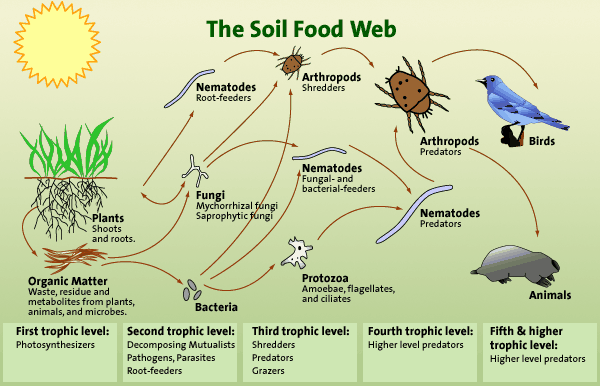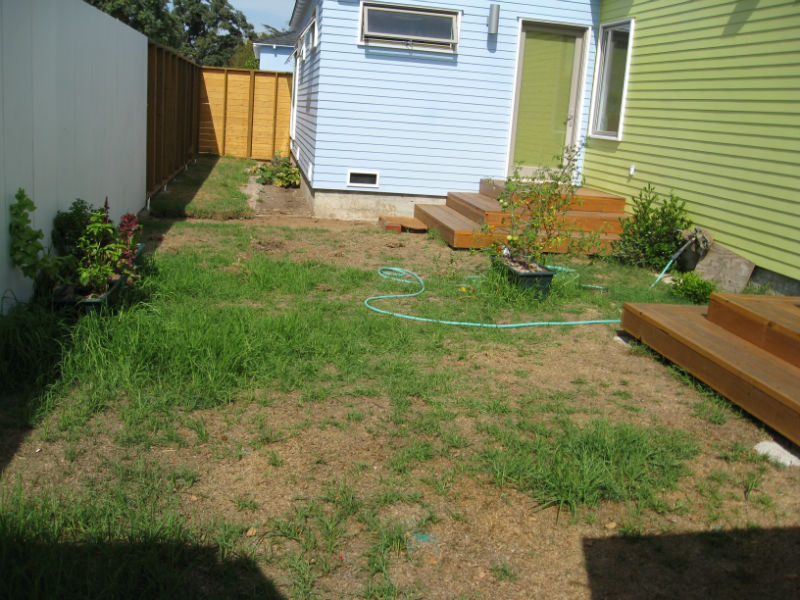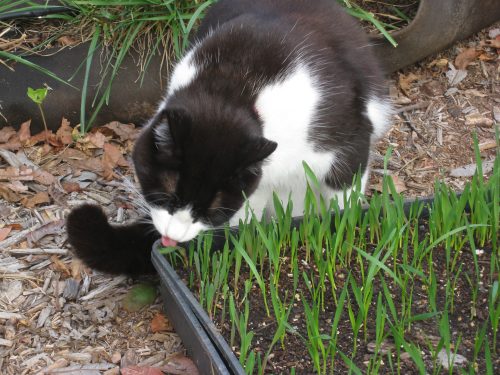I’ve just returned from spending 5 glorious days with Dr. Elaine Ingham, the soil microbiologist who coined the term “Soil Food Web.” It was, indeed, intense. Even though I’d been circling this information since 2009 when I saw Jeff Lowenfels speak about the Soil Food Web and his then upcoming book, Teaming with Microbes, at the San Fransisco Garden Show, there’s nothing like getting it from the source.
Dr. Elaine Ingham has been solving soil issues around the world, soil issues that seem impossible to cure, soil issues (and subsequently plant issues) that we all take for granted as “part of gardening” and just deal with it. She’s fixing them with microbes. She’s getting soil back in balance so it can do what it’s supposed to do–she’s restoring homeostasis.

But first, what is the Soil Food Web? Get the deets from our 2012 guest blogger, Sheri Powell of Compost Teana. The Soil Food Web makes plants grow. If plants won’t grow in that soil, it’s not for lack of nutrients, it’s actually for lack of the proper biology in the soil.
Dr. Inghams starts her talks by saying that there is no soil in the world that lacks what is required to grow plants. Hard to believe? When she’s done explaining, you’ll see why it’s true. Here are my takeaways from the first two days:
1) Soil pH is dictated by plants
We all think of pH as something that just “is” or as something we try to manipulate with lime or sulfur in order to grow certain plants. Guess what…the plant determines what pH it needs. Here’s how:
Bacteria and fungi in the Soil Food Web consume exudates from plants: sugars put out by plant roots to feed bacteria and fungi in the soil. Bacteria consumes these sugars and converts them into nitrates, and fungi consumes them (humic acids, to be specific) and synthesizes ammonium. It just so happens that nitrates make soils more alkaline and ammonium makes soils more acidic. So the plant puts out specific foods to attract the microbes it wants to utilize to create these specific nutrients that adjust pH.

Therefore, if you give the plant the means to take care of itself it will do so. What does this look like? We’ll get to that in a minute. But first…
2) Succession – and why it matters
Plant systems range from grasslands to food gardens to forests. Grasslands tend to have alkaline soil and forests have acidic soil. Vegetable gardens are somewhere in between. If we look at the traits and behaviors of plants in these systems we can diagnose soil issues. Here’s how:
In the image above Dr. Ingham illustrates how the bacteria to fungi ratio (B:F) effects what can be grown in those soils. On the left, bacteria count is high, fungi count is low. This means that the most prevalent nutrient is nitrates (NO3). What grows best in high nitrate situations? Grasses and weeds. (Got weeds in your garden?) As we move more toward forest systems, there is a higher fungi count and lower bacteria count in soils. This means that the most prevalent nutrient is ammonium (NH4), therefore the soil is more acidic. What grows best in these soils? Perennials: shrubs, deciduous trees and conifers.
Therefore, if we have gardens full of weeds, we probably have a higher B:F ratio (more bacteria than fungi) in our soil. Forests don’t really have weeds, do they? Nobody is going in there to weed. Forests self regulate. Wouldn’t it be nice to have a garden that self regulates? With the right soil biology we can.

Oh, and BTW – did you know that you can lose up to 60% of the organic matter in bacterially dominant soils vs. only 20% in fungally dominant soil? Therefore, fungally dominant soils make for better carbon sequestration.
3) Compaction=anaerobic
Clay soils are difficult to dig, so we often grab the tiller to prepare our soils for spring planting. The problem is that tilling not only tears your Soil Food Web to shreds, it creates a layer of compaction right beneath that tilled soil. Farmers deal with this problem all the time. Historically our tilling equipment has increased from reaching 12″ down into our soils to reaching 4 feet down in order to break up the previous year’s compaction layer.
Compaction means there is not enough space for oxygen to flow through the soil. When soil (or compost) lacks oxygen, anaerobic bacteria grow. These are the bad guys; the bacteria responsible for the smell of garbage. Anaerobic bacteria put the kibosh on nutrient cycling, so plants don’t get the nutrients they need (nor the oxygen). So if you have compacted soil, you can almost guarantee that you have an anaerobic microbe situation in your soil. The good news is that a good dose of the right microbes and some food for those microbes can solve this issue.

What are good foods for microbes?
Compost – think of compost as an inoculum rather than fertilizer. When you put down a layer of good quality compost, you are inoculating your soil with beneficial microbes that will cycle nutrients and give plants what they need to grow. Want to make good compost? Find out in this post about the composting intensive I took in 2012 with Alane Weber (one of Dr. Ingham’s colleagues). Of course, we also have a compost recipe from Dr. Ingham in Gardening for Geeks.
Humic acids – naturally present in good quality compost, humic acids feed fungi, making way for healthy soil. You can purchase humic acids or extract them from your own compost pile by gently pouring water over compost through a sieve. Dilute and spray humic acids on leaves and soil (a little bit goes a long way).
Kelp – both a good fungal and bacterial food.
Alfalfa – both a high nitrogen ingredient in compost making, and a good fungal food for compost tea.
Emulsions – fish emulsion (which has had the oils removed through a heating process) is good bacterial food. Fish hydrolisate (which contains the oils in tact) is fungal food.
Mulch – mulch is carbon-rich. Fungi feeds on carbon. Therefore, it’s good fungal food. Just make sure to avoid redwood, cedar and pine mulches until you can no longer smell the oils in these woods. They are naturally anti-microbial when fresh.
These foods (and others) will help increase the numbers of beneficial microbes in your soil as well as assist in the nutrient cycling tasks these microbe perform.
Our brains were exploding after two days of Soil Food Web training. Stay tuned for more on compost, compost tea and how to deal with plant diseases with microbes…
Update: Read Part 2 of our Soil Food Web adventure.



Pingback: Podcast: Regenerative Techniques with David White - Gardenerd
Pingback: YouTube: How to Apply Beneficial Nematodes to Control Pests in Your Garden - Gardenerd
Pingback: Podcast: Spring Gardening Questions with Christy - Gardenerd
I find the teachings of Dr. Ingham fascinating with the emphasis on producing soil conditions to encourage more fungal growth. If is often said that one doesn’t want to moldboard plow as it sets back the soil fauna. I would be interested to know what equipment/techniques are employed regarding seedbed preparation for field crops.
She bought a farm in Corvalis, OR a while back and has been running tests on farmland up there. I’m guessing she’s posting details on her website or will be publishing her findings in the coming years. When I took her class she shared stories of how, on compacted fields, they would run the plow with an injection tube to deposit microbes down at the hardpan layer to begin to break it up. They would lay 1/4″ of biologically active compost on the surface and that would be enough to restore some balance and bring the soil back to life. I’m not completely sure of all the details (they probably did more, like spray compost tea or something) but you get the idea.
I am involved in a book project on the Mint Family of Plants: Lamiaceae. I would like to obtain permission to use your chart of the Soil Food Web in my book. I would be happy to give appropriate credit in the book. Please advise if this would be okay.
HI Randy, Permission is not mine to give. All of us SoilFoodWeb folks have borrowed it from Dr. Eliane Ingham and use it, although it may have come from someone else. Jeff Lowenfels uses it in his Teaming with Microbes book as well. If you search for images of the soil food web you’ll see it under a couple of University sites as well. It may be open source, but you can probably find out from one of the Universities if it is trademarked.
Pingback: Ask Gardenerd: Make my Hydrangea Blue - Gardenerd
Great info. If anyone is really interested in knowing more I highly recommend two books:
Teaming with Microbes by Jeff Lowenfels and Wayne Lewis
Teaming with Nutrients by Jeff Lowenfels
They have been great bedside reading ! Worth every penny!
Hi Christy. Thanks so much for such a great explanation. Soil science is fascinating once you get into it. Cheers Sarah : o )